How Sydney's Infrastructure Boom Will Affect Rentals In Sydney's East
Sydney’s Eastern Suburbs is already serviced by reasonably good transport, amenities and infrastructure, making it popular with renters and investors alike. The great news is that new infrastructure upgrades and projects should see this area grow more des
It’s no secret that infrastructure upgrades can have a positive effect on both property prices and rental yields and right now, Sydney is going through an unprecedented infrastructure building boom. Here’s how we see planned and recent infrastructure upgrades affecting Eastern Suburbs rental properties, and what landlords and investors can expect in both the short and long term.
What’s Here Already?
Sydney’s Eastern suburbs have always been a popular place to live. Little wonder when it boasts commercial centres such as Bondi Junction, Edgecliff and Double Bay, easy access to the airport and a short commute to the CBD. There are also some of the country’s very best schools, universities, hospitals and other amenities.
And then there is the lifestyle.
The Eastern Suburbs’ beaches, harbourside reserves, amazing views, and relaxed vibe bring in people from all over the world who want to live in this amazing location and take advantage of a way of life that no city in the world can match.
These assets make it a blue ribbon investment location, and the market for buyers and renters is - and probably always will be - a competitive one.
But changes are coming, and rather than detracting from the desirability of the East as a place to live, they look set to make it even more popular. Here are the three new upgrades we think will have the biggest impact on property prices and rents.
The New Light Rail
If you’ve driven along Anzac Parade in the past year, it would have been impossible to miss seeing the construction of Sydney’s light rail. Set to start running in 2019, it will stretch from the centre of the Sydney CBD, through Surry Hills and past the Sydney Cricket Ground before branching out to service Randwick, via Alison Road, the Randwick Racecourse and UNSW, and Kingsford and Kensington via Anzac Parade.
In doing so, it will supplement existing bus services and give commuters another reliable way to get into the city - or to key facilities - fast.
While it’s still early days when it comes to delivering the overall impact of the light rail, it’s worth noting that the average unit price in Randwick lept from $850,000 to $947,000 between September 2016 and August 2017, according to RP Data. That’s a gain of 11.4%.
Westconnex
The somewhat controversial Westconnex project should have an impact on many of the suburbs on the southern fringe of the East, such as Mascot, Zetland, Daceyville and Botany.
Part of the project, which the State government is billing as the largest infrastructure project ever seen in Australia, aims to ease congestion around the airport and link the M4 and M5 motorways. In the process, it should take trucks and other heavy traffic off local roads, benefiting both the safety and commuting times of local residents.
Westconnex won’t be completed until 2023, so it’s a little early to tell exactly what effect this will have on property prices. However, many of the suburbs impact by the project have already been growing strongly over the past few years. For instance, Botany’s average property price (both units and houses) grew from just $877,000 at the start of 2014, to $1,435,000 by August 2017, according to CoreLogic, while the average rental yield sits at 3.8% for units, and 2.7% overall.
Residential Developments and Re-development
Not all infrastructure and development spending is government-funded. Private residential development and redevelopment is a key feature of the property market all over Sydney, and the East is no exception.
In the inner-East - from Surry Hills to Alexandria and Rosebery - private developers have been turning many old commercial or industrial spaces into new, often high density, residential buildings, including both apartments and townhouses.
One area in particular that’s undergoing regeneration is Green Square, where the City of Sydney Council estimates 61,000 new residents will live by 2030. As part of this re-development, government-owned Landcom and developer, Mirvac, have joined forces to deliver a new town centre.
New properties offer scope for investors to buy into well-located areas that once had limited housing stock. It also gives them the opportunity to capitalise on buying newly built or off-the-plan properties and to take advantage of the potential tax breaks that can sometimes bring.
While some commentators worry about a glut of new properties, there is usually no insurance policy for investors like being close to infrastructure and transport. Sydney’s East is evidence of this, where demand from renters and investors remains strong.
As the population grows and more people look to take advantage of being close to where they work and play, we expect demand for rental properties in the East to grow further still.
